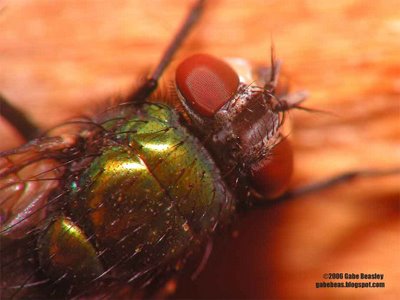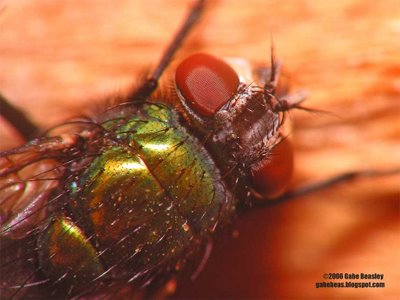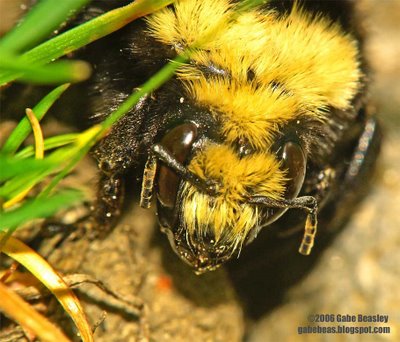 (above and below)
(above and below)THESE TWO FLY SHOTS are the same picture processed slightly differently. I wanted a reference for myself to see as well as anyone else. These shots where done with a reversed old but nice 50mm Pentax lens. Of course it works well on my Pentax, but reversed and added to my Z10 camera. I bought the Z10 because it has all-internal large and good optics)--and it has many SLR-style menu-features including ISO down to 64, histograms, and and up to ISO400 with an incredible lack of noise not seen in any compact I've ever used! (When the noise filter option is turned on) a huge menu of options concerting files-flash and button controls to make it easy to use and extremely versatile. With an all optical 290 zoom tile-photo built in (equil-35mm).
The plans for exactly how the rig works I won't publish. I'm tired of writing long and complicated descriptions about things that people probably never read.
TO SEE SUBTLE DIFFERENCES IN THESE TWO PICTURES-CLICK ON THEM!
 Once again--these are the first crude shots done with the system I'm talking about. Very painful shots before I had the mechanics that make the camera a whole camera working--in fact I was holding the heavy contraption together over my head-ouch! That old lens made for a higher depth of field then most of my other lenses. It happens to be the right size to fit onto the compact which is now fitted onto a mount so the unit is a solid re-built camera I call the X1--(what else would you name a half home-made cool close up only camera).
Once again--these are the first crude shots done with the system I'm talking about. Very painful shots before I had the mechanics that make the camera a whole camera working--in fact I was holding the heavy contraption together over my head-ouch! That old lens made for a higher depth of field then most of my other lenses. It happens to be the right size to fit onto the compact which is now fitted onto a mount so the unit is a solid re-built camera I call the X1--(what else would you name a half home-made cool close up only camera).
This bumble bee was stuck because of the windy cool day, or it had been bit by a spider? Unable to fly--I got this picture and a few other ones. This picture reminded me of some lessons I learned or re-learned when I took it yesterday. Take natural shots-don't try to pose bugs too much, and when you are at it--make sure you got your white balance right! You might notice a problem with this shot. When you are using a digital SLR or an advanced compact with manual functions like white balance, be sure to get your white balance correctly and or shoot in RAW so that you can change it later. With my digital SLR I can change it in-camera before I even get to my computer. After about an hour, I gave up thinking I could really fix my white balance later in Photoshop. I shot this bee in a very large JPEG file to save more space then RAW--but in so doing I sacrificed my ability to truly change the white balance. Check your settings! There are only limited ways to really fix white balance problems in JPEG files. This picture may look really cropped but it's not. The full version is great as I shoot for new depths of field in macro photography. Be sure to shoot in RAW whenever you can so that you are able to post shoot adjust your white balance. White balance is basically the 'color map' of the photo. It is more or less the scope of how colors get recorded in a digital image. It acts like a hue or color control but really it's a control to balance the kind of light that hits the sensor and how that effects the image and it's colors. It is measured in Kelvins. Most pictures are taken from about 2500k to 10000k. Things light florescent lights can seriously effect white balance in a shot because they make pulsed light. Color diffusion from clouds and other factors can also cause changes in white balance. It is important to understand and know how this works to take color-accurate shots. Shooting RAW is the best way since you can change your white balance settings completely even after the shot was taken almost as if you are taking the shot all over again.
 This shot is of another stranded bee. I'm guessing it is our spring patterns here. Freezing at night--yesterday it was at least in the 80s. The day before it was in the 60s. Insects can often get stranded and killed by these factors. Like flowers that bloom to early--they die and loose out. This bee was on the edge of a local high wooden fence and I was able to get very close to it easy. Too bad I had not built the "X1" yet. Next time I will be ready for that super-macro!
This shot is of another stranded bee. I'm guessing it is our spring patterns here. Freezing at night--yesterday it was at least in the 80s. The day before it was in the 60s. Insects can often get stranded and killed by these factors. Like flowers that bloom to early--they die and loose out. This bee was on the edge of a local high wooden fence and I was able to get very close to it easy. Too bad I had not built the "X1" yet. Next time I will be ready for that super-macro! As I shot some local flowers I was waiting for the moment that I could capture a busy bee. In this case--I just had enough settings to get a partial stop action looking shot of this honey bee at work. I was lucky--it takes hours to get these pictures because you have to keep trying and trying. Small things can move a lot faster and even with a very good AF system that will track for you--your are likely to take at least 20+ shots per shot worth keeping. Except those few really lucky shots!
As I shot some local flowers I was waiting for the moment that I could capture a busy bee. In this case--I just had enough settings to get a partial stop action looking shot of this honey bee at work. I was lucky--it takes hours to get these pictures because you have to keep trying and trying. Small things can move a lot faster and even with a very good AF system that will track for you--your are likely to take at least 20+ shots per shot worth keeping. Except those few really lucky shots!
No comments:
Post a Comment